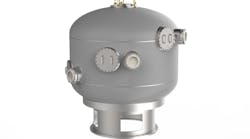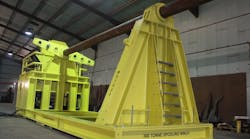Editor's note: This Renewable Energy column first appeared in the September-October 2023 issue of Offshore magazine. Click here to view the full issue.
By Bruce Beaubouef, Houston
As the search for sources of renewable offshore energy continues, researchers and developers continue to make progress on various wave energy technologies, as demonstrated in a series of recent field trials and pilot projects.
Mocean Energy reports that it has secured over €3.75 million ($4.02 million) of funding under Phase 3 of the EuropeWave pre-commercial procurement program to develop and deploy a 250-kW wave energy machine in Orkney, northern Scotland.
The company will manufacture the Blue Horizon 250 system in Scotland and deploy it in a grid-connected berth at the European Marine Energy Centre (EMEC) in Orkney, potentially in 2025. Ultimately the development could open the way to construction of a small offshore wave energy farm delivering 1-2 MW by 2030.
Mocean Energy was one of three wave companies awarded funds in Phase 3, after passing competitive stage gates in Phases 1 and 2. The others were IDOM Consulting and CETO Wave Energy Ireland, which will install their devices at the Biscay Marine Energy Platform (BiMEP) in northern Spain.
Currently Mocean participates in the Renewables for Subsea Power program which has connected Mocean’s 10kW Blue X wave energy prototype with a Halo underwater battery system developed by Verlume.
The two technologies are installed offshore Orkney supplying power and communication to infrastructure that includes Baker Hughes subsea controls equipment and a resident AUV provided by Transmark Subsea. The program is supported by industry partners and the Net Zero Technology Centre in Aberdeen.
Blue Horizon 250 will be a scale up from Blue X and is designed for commercial applications on islands and remote communities, but will also encompass early grid projects and off-grid applications, such as oil and gas and aquaculture.
Phase 3 will involve the detailed design, full-scale construction, and sea tests over a 12-month period of a wave energy converter at EMEC, with a view to attaining technology readiness level TRL6/7 (TRL1-9 scale).
Meanwhile, CorPower Ocean says that it has installed its first commercial Wave Energy Converter offshore northern Portugal.
The CorPower C4 system was launched at the port of Viana do Castello, then towed to the Aguçadoura site four kilometers offshore. It was then connected to a pre-installed UMACK anchor on the seabed and linked to Portugal’s national grid through a subsea export cable.
It will now undergo a commissioning, with functions and operational modes being gradually verified, and operations and maintenance methods for offshore service access, device retrieval and tow-back to the base in Viana do Castelo also undergoing tests.
Previously the C4 previously completed a one-year dry test program with simulated wave loading in Stockholm, in order to fine-tune and debug the system. Technology includes inherent storm protection for extreme conditions and phase control for amplified power capture in regular sea states.
This is part of the Hiwave-5 project co-funded by the Swedish Energy Agency and Portugal 2020 through AICEP Global (Norte2020) and CCDR-N. CorPower Ocean also has financial supported from EIT InnoEnergy, the European Commission, Wave Energy Scotland, CoreSpring New Technology, ALMI Invest Greentech, SEB Greentech VC and other private investors.
Other forms of support are coming from power utilities and project developers looking to commercialize wave energy technology, such as the EU-SCORES project partners ENEL Green Power, EDP and Simply Blue Group.
Elsewhere, earlier this year Eni completed the installation of what it says is the world’s first ISWEC (Inertial Sea Wave Energy Converter) device connected to the electricity grid of an island.
It is located about 800 m off the coast of the island of Pantelleria and can reach 260 kW of peak power generation converted from wave energy. This experimental campaign, conducted under real operating conditions, will lead to useful results for developing the second-generation device currently under study, Eni said.
ISWEC was developed by Eni in collaboration with the Politecnico di Torino and Wave for Energy s.r.l. (a spinoff of the university). The technology converts wave motion into electricity, which then supplies energy to offshore infrastructure, small off-grid islands and coastal communities. The ISWEC design can be optimized with reference to the metocean conditions of the site where it is installed by means of a genetic algorithm that leverages on the significant computing power of Eni’s Green Data Centre based in Ferrera Erbognone.
The machine consists of a steel hull measuring 8 m by 15 m, which houses the energy conversion system, consisting of two gyroscopic units, each more than 2 m in diameter. The device is held in place in a 35-m deep seabed by a special mooring system that responds to weather and sea conditions, consisting of three mooring lines and a swivel (a rotating joint). The electricity produced is transmitted ashore via an underwater electric cable.
The technology also offers considerable reduction of its impact on the landscape, since the device stands only 1 m above sea water.
Moreover, ISWEC can be integrated perfectly with other offshore renewable energy production systems, such as wind power generators, both because it enhances the value of connection systems and because it can be integrated with other facilities in the same sea area, thereby maximizing the conversion of available energy, Eni said.





